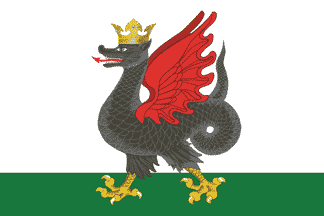
Last modified: 2014-06-01 by zoltán horváth
Keywords: wyvern (black and red) | crown (golden) | crown (3 stems) | kazanh | kazan’ | Казань | kazan | qazan |
Links: FOTW homepage |
search |
disclaimer and copyright |
write us |
mirrors

City of Kazan, capital of Republic of Tatarstan
in Russian Federation, adopted 24 Nov 2004 (decision
number 37-21) a municipal flag. Att. w:v=4:1.
Mikhail Revnivtsev, 13 Feb 2005
Quoting Jiri Louda’s European Civic Coats of Arms [lou66]:
Kazan was founded on the site of the old village Bolgary settled by Tartar Bulgarians. Built in the 13th century in the reign of the Khan Sayan, the new town became the chief town of a khanate and has been the capital of the Tartar Republic since 1920. As early as the late 16th century, Kazan bore a basilisk (or dragon) on its seal, a device which was approved for the town arms in 1781.According to Victor Louis’ The Complete Guide to the Soviet Union, the CoA of Kazan is «argent a black dragon with red wings under the golden crown of Kazan»; approved 1730. — Louis tells a long story about the origins of Kazan, wherein the site originally was infested with snakes.
On further research, "basilisk" is wrong; that is a wyvern with a
dragon’s head at the end of its tail; this is a wyvern, a 2-legged
dragon.
Albert Kirsch, 14 Feb 2005
In the official description in Regulations about a flag he refers to as
dragon (in Russian — Змеи). The original name
in the Kazan-Tatar mythology is Zilant. It has been represented on
so-called Flag of Caesar of Tatars in Carlus
Alyard’s book of flags [ala94] at the end of
17 centuries — at begin of 18 c.
Mikhail Revnivtsev, 14 and 13 Feb 2005
This one shown is a true heraldic dragon:
four feet, two wings.
Albert Kirsch, 14 Feb 2005
[This flag is remarkably similar to the flag of
Wales.]
James Dignan, 13 Feb 2005
Anything below this line was not added by the editor of this page.